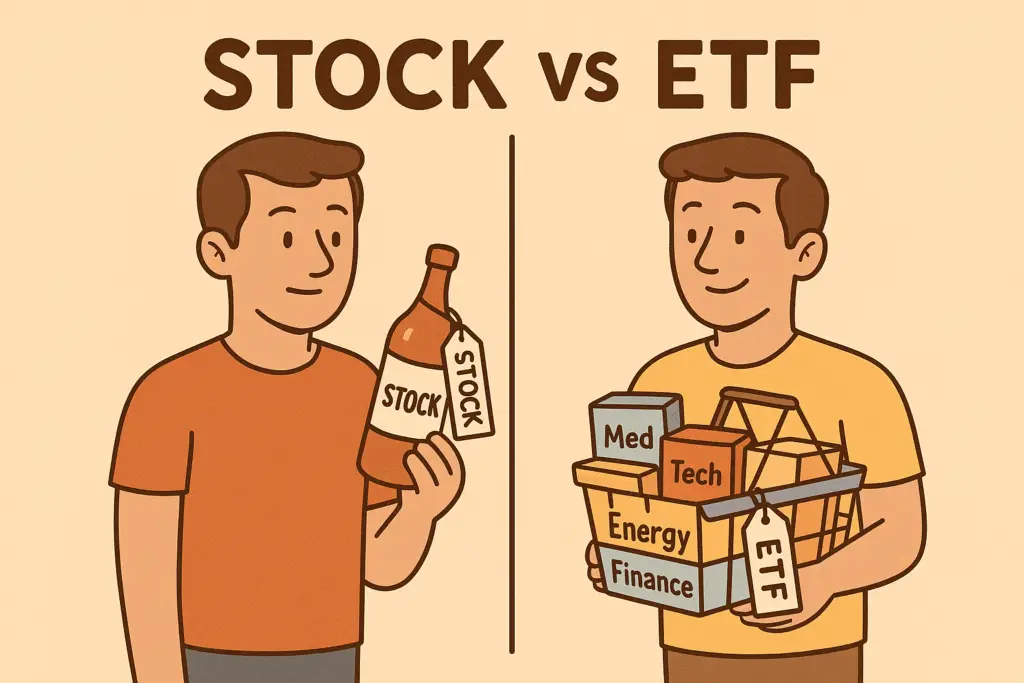If you’re just getting into investing, you’ve probably seen the terms stock and ETF pop up everywhere. They’re closely related, but not the same thing. In this article, I’ll explain both concepts, highlight their differences, and give you a few tips to help you choose what’s right for you as a beginner. We’ll also cover some common mistakes to avoid.
Quick Overview: What’s the Stock Market?
No worries, I won’t take you on a historical tour of Wall Street. But it’s useful to understand what the stock market actually is.
The stock market is a marketplace where people buy and sell ownership in companies. It’s not just one place, it’s made up of exchanges like the NASDAQ, New York Stock Exchange (NYSE), London Stock Exchange (LSE), and Euronext Amsterdam. A stock might be listed on several exchanges, but buying on one doesn’t mean you can sell it on another.
What Is a Stock?
A stock represents a share in the ownership of a company. When you buy a stock, you become a shareholder, a (very small) part-owner of that business. These are known as public stocks, because they’re traded on public exchanges.
Companies sell stock to raise money, an alternative to taking out loans or finding private investors. When a company performs well, its stock often increases in value, rewarding shareholders.
However, that’s not always the case. A stock can be undervalued (priced too low) or overvalued (priced too high), and sometimes the market will correct itself. A correction is when the price of a stock or market drops by at least 10% to bring it more in line with its actual value.
Tip: You don’t need to master advanced stock types to get started. Even experienced investors often stick with the basics.
Pros of owning individual stocks:
- You have more control, you choose exactly what to invest in.
- Potential for higher returns if you pick a winning company.
- You can focus on sectors or companies you believe in.
Cons:
- Higher risk, if the company fails, so does your investment.
- Requires research and regular attention.
- Less diversified, owning one or two companies puts all your eggs in very few baskets.
What Is an ETF?
An ETF (Exchange Traded Fund) is a collection of many different stocks bundled together. Think of it like a shopping basket full of groceries: you’re buying a little piece of each item in the basket all at once.
The most well-known example is an S&P 500 ETF, which holds shares in the 500 biggest public companies in the U.S. Buying shares in all 500 individually would be expensive, but buying one ETF share gives you access to all of them.
Pros of ETFs:
- Built-in diversification, you’re not betting on just one company.
- Generally lower risk than individual stocks.
- Good for a hands-off, beginner-friendly approach.
Cons:
- Lower potential reward compared to a lucky stock pick.
- Less control over what’s in the basket.
- You might still need to pay small management fees (called expense ratios).
Key Differences at a Glance
| Feature | Stocks | ETFs |
| Risk | Higher (depends on company) | Lower (spread across multiple stocks) |
| Diversification | Low (unless you own many) | High (one ETF can cover 100+ companies) |
| Cost | None after buying, but volatile | Usually low fees, less volatility |
| Management | You research and manage | Passive (managed by fund managers) |
| Accessibility | Requires more knowledge | Widely available, easier for beginners |
| Best for… | Active investors, stock pickers | Beginners, passive investors, lower stress |
When Would You Choose One Over the Other?
You might prefer stocks if:
- You enjoy researching companies.
- You want more control over your portfolio.
- You’re okay with higher risk in exchange for higher potential returns.
You might prefer ETFs if:
- You want easy diversification.
- You’d rather not spend hours researching companies.
- You’re starting out and want to limit risk.
There’s no rule that says you can’t use both. Many investors build a core of ETFs and add a few hand-picked stocks as they gain confidence, but only after they’ve built confidence in their circle of competence.
Final Thoughts
If you’re just getting started, go with an ETF or two. It’s an easy and smart way to dip your toes in. As you learn, you can slowly explore individual stocks that interest you.
Start simple, diversify a bit, and don’t spread yourself too thin. A good beginner setup might include:
- 1–2 ETFs (e.g., an S&P 500 ETF and a global ETF)
- 1–3 individual stocks in different sectors (e.g., tech, healthcare, consumer goods)
Keep in mind: an ETF requires less research, but there are still good and bad options. In a later post I will highlight some of the better options out there. Here are some key questions to ask before making your pick (Learn more about dividends in depth → What Are Dividends):
- What does this company do? (for stocks)
- What’s inside this ETF in terms of companies or sectors? (for ETFs)
- What’s the risk?
- What is the dividend/yield?
- How has it been performing?
- Is it widely trusted?
Most importantly, don’t wait for the perfect setup to get started. A bit of research goes a long way. If you’ve read this far, you already know more than most new investors.

